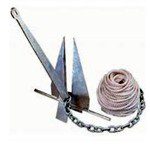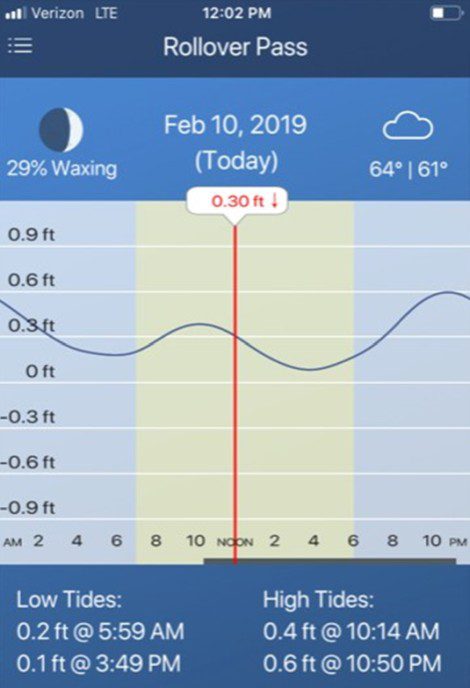 By Bob Currie, Recreational Boating Safety Specialist
By Bob Currie, Recreational Boating Safety Specialist
U. S. Coast Guard Auxiliary Base Galveston Flotilla
As long as the earth’s surface is not completely covered with water, there will be boat groundings; that is, the boat is no longer floating free but instead is stuck on the water’s bottom. There are two types of groundings: soft groundings and hard groundings.
Soft Groundings
A soft grounding occurs when your boat bottom contacts the water bottom and the boat stops and won’t move. Soft groundings usually occur at low speed and usually result in just being stuck in the mud or sand. Because they usually occur at low speed, there is often little or no damage to the boat or injuries to the passengers. Soft groundings occur where the water depth gradually decreases as you get close to shore. A soft grounding may be described as any grounding that you can free your own boat, even if it takes a great deal of time, or wind, wave, or tide action to help. Soft groundings occur in mud, silt, and sand. This column will discuss methods you can use to refloat your boat and get to deeper water. Before doing anything, check for leaks due to hull damage.
Passing Boat
You may shake your fist at that speedboat that passes close enough to really rock your boat with its wake, but that same wake could be used to briefly float your boat enough to push it back into deeper water. You have to time the wake just right, but you usually have enough time to prepare before the wake hits. If the bow is stuck, shift your passengers toward the stern, and use a paddle or pole to push off when the bow briefly becomes free of the bottom.
Power Out
If only your bow is stuck and your stern is free, sometimes you can power out of being stuck by trying to go forward with the rudder turned toward deeper water. This is a tricky maneuver because you risk making your boat stuck harder than it was to begin with. Briefly putting the engine in reverse and applying power may work as long as the propeller isn’t stuck in the mud.
Many boat operators raise their engines as far as they can when operating in shallow water. This works to a degree, but by raising the engine all the way you take away any chance of using the engine if the engine skeg digs into the bottom. If you raise the engine only partially, if your skeg does get stuck on the bottom you then have some wiggle room and often you can free your boat by then raising the engine all the way.
Be sure to keep your water intake below the surface if you plan to try to power out of being stuck. If raising your engine all the way will free the skeg, then turn your engine off and use a paddle or pole to push your boat to deeper water. Keep that intake out of the mud so you don’t clog it up and burn up your engine. Once you free your boat be sure to observe that water is circulating through the engine by verifying that water is coming out of the water pump indicator hole (pee hole).
Shift Weight and Reverse
If only the bow is stuck, shift weight to the stern and use reverse. This does not work if the skeg is stuck in the sand or mud. Be sure the engine is free of the bottom and raise the engine slightly before applying power. Do not use full power and the engine could damage the transom by trying to flip over into the boat.
Shift Weight and Push
If the water is too shallow at the stern to use your engine because the water intake is above the surface, then turn the engine off, raise the engine all the way, shift weight to the part of the boat that is not grounded, then use a paddle or pole to push to deeper water. Sometimes rocking the boat from side to side will help with this method.
Grounded on Firm Bottom
If you ground on firm bottom and the methods above have been tried, then you may have to exit the boat and push. This can be a very dangerous proposition because you might find yourself sinking up to your waist in silt. Use a deck line to tie yourself to the boat in case you slip and the boat floats away from you. That line can also be used to help pull yourself out of deep silt. Walk on the bottom only as far as is need to free the boat.
Use Your Anchor
If you are grounded on a muddy bottom this method has good success.  Normally an anchor should be lowered gently into the water. In this case, you want to throw the anchor as far as you can toward deeper water, allow the anchor to sink to the bottom, set the anchor, and then reel the anchor in slowly so you don’t dislodge it from the bottom. It helps if the anchor is the Danforth type (like this one) and has tines that dig into the bottom.
Normally an anchor should be lowered gently into the water. In this case, you want to throw the anchor as far as you can toward deeper water, allow the anchor to sink to the bottom, set the anchor, and then reel the anchor in slowly so you don’t dislodge it from the bottom. It helps if the anchor is the Danforth type (like this one) and has tines that dig into the bottom.
Luke, Use the Tide!
Well, even Obi Wan Kenobi knows the tide is a great force! The tide is your friend when operating in or near shallow water. Many a boater has found themself stuck and had to wait on the rising tide to free their boat. This could take hours, so be sure you have plenty of water and some food such as protein bars to snack on. Depending on where on the tide chart you were at the time you got stuck, you could get as much as a foot increase in water depth if you wait on a rising tide. If you find yourself on a lowering tide, you may have quite a wait before you find an increase in water depth due to a rising tide. Hopefully you have some way of communicating with the person with whom you left your float plan to let them know the situation. Use the wait time to do a little topwater fishing!

If we find ourselves grounded at noon, if you look at the chart you will see that it will be about seven hours before the water depth begins to increase, and probably eight hours before the increase is enough to float our boat. Lesson from this: Don’t go out on waning tides! Plan your trip around the tides for the area in which you plan to operate.
The Good Sam
A person who voluntarily comes to your aid is known as a Good Samaritan, or Good Sam for short. A Good Samaritan may well be the answer to your problem. If your boat is reachable from water that is deep enough for a Good Sam’s boat, you may find someone willing to give you a pull off the soft bottom. This procedure can also be quite dangerous because you can easily overload the tow line and cause it to snap with great force. If you do get someone to give you a tow, be sure to instruct everyone to stay out of the path of the line should it break. Towing is another discussion, but be aware of the dangers inherent in trying to unground a boat using a towing line.
Commercial Tow
If all other methods have either been exhausted or you don’t wish to try them, your next to last option is to call for a commercial tow. The two most common towing services are Sea Tow and BoatUS. You may find one or both operating in your area. Both services offer subscriptions to their services. I always recommend participating in such a service as the alternative is much, much more expensive, depending on your location and your circumstances. If you don’t have a towing service subscription, they may come, but you have to provide a good credit card number before they push away from the dock to come see you.
Government Agency
Oh yes, the U.S. Coast Guard is a government agency. We have rescued many people who have been grounded. Depending on the circumstances, the Coast Guard, or another government agency such as the game wardens or sheriff’s boat, will recue you from a grounded boat. They may or may not attempt to unground it due to safety concerns. People come first when it comes to rescues.
Prevention
Who wants to be grounded? Nobody! So, why don’t you operate in a manner that prevents you from being grounded instead? It’s simple: operate according to the tides, use charts that give depths, use a depth finder such as is found on the typical GPS system, use a pole to judge depth (my neighbor’s number one method is an eight foot PVC pipe), and use your knowledge of the area to keep from grounding. When operating near shallow water, don’t go flying in on plane, because when you come off plane you may find yourself not only grounded but grounded a great distance from water deep enough to float your boat. Use your trolling motor to operate in shallow water. Your trolling motor will start chopping bottom before you get grounded. Stay away from areas known to have silty or soft mud bottoms. Sandy bottoms are the safest for shallow water operation.
Summary
I have given you ten ways to get ungrounded, but the best way to operate is to use prevention methods to keep from being grounded. Cold weather is coming, and our attention will shift from avoiding hyperthermia to avoiding hypothermia. We have several deaths every year attributed to both conditions. The old standby description is “He died of exposure.” Being grounded is one thing, but being grounded and no one knows where you could possibly be is another thing.
File a float plan, be prepared for extreme temperature changes, have plenty of food and water, have communication, and have visual distress signals such as rockets and flares. People spend more on ice than a pack of flares costs. Don’t skimp on safety.
[BC: Oct-31-2023]

 Posted in
Posted in 























